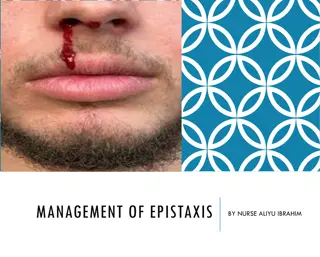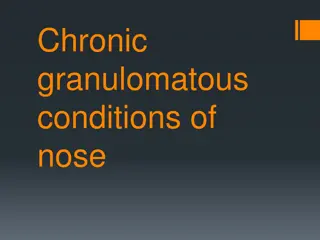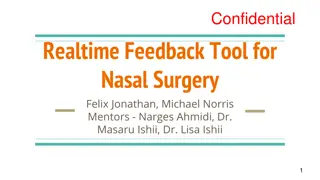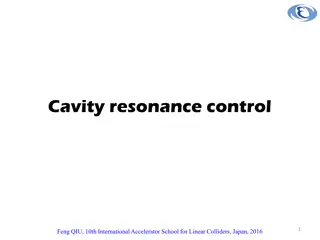FPC & HOM Technology Challenges, FCC
The challenges and technology involved in coupling beam power out of the cavity and coupling RF power into the cavity for the Future Circular Collider (FCC). It also covers the RF layout for the FCC-ee, basic parameters for proton and electron beams, accelerating RF in the LHC, input couplers, and p
0 views • 36 slides
Understanding Rhinosinusitis: Symptoms, Causes, and Classification
Rhinosinusitis, formerly known as sinusitis, is an inflammation affecting the paranasal sinuses, nasal mucosa, and nasal cavity. This condition is categorized based on the duration of symptoms as acute, subacute, or chronic. Various factors contribute to the development of rhinosinusitis, including
3 views • 46 slides
Pharmaceutical Technology Lab: Nasal and Ear Drops Formulations
Learn about the formulation and use of nasal and ear drops in pharmaceutical technology labs. Explore details on nasal drops for nasal passages, ephedrine nasal drop recipe, notes on ingredients, ear drops for ear care, sodium bicarbonate ear drop recipe, and procedures for preparation. Understand t
2 views • 13 slides
Advanced Cryomodule Technology for China's Spallation Neutron Source Upgrade
This article discusses the development of a Double-Spoke Cavity Cryomodule for the China Spallation Neutron Source (CSNS) project. It covers the structure of the cryomodule, integration processes, future work, and details about the CSNS beam parameters and upgrade scheme. The content includes images
0 views • 19 slides
Comprehensive Guide to Epistaxis Management by Nurse Aliyu Ibrahim
Bleeding from the nose, known as epistaxis, can stem from various factors and regions within the nasal cavity. Understanding the epidemiology, anatomy, and blood supply of the nose is essential for effective management. This guide delves into the causes, symptoms, classification, diagnostic evaluati
0 views • 24 slides
Understanding Atrophic Rhinitis: Causes, Symptoms, and Diagnosis
Atrophic rhinitis is a progressive chronic condition characterized by the atrophy of nasal mucosa and turbinates. It predominantly affects young to middle-aged adults, with females being more prone. Commonly isolated bacteria include Klebsiella ozaenae and others. The pathophysiology involves metapl
0 views • 12 slides
Overview of Superfamilies in Order Strongylida Nematodes
The Order Strongylida in nematodes encompasses four main superfamilies - Trichostrongyloidea, Strongyloidea, Ancylostomoidea, and Metastrongyloidea. Each superfamily is defined by distinct characteristics such as buccal cavity size and location within the host, as well as differences in life cycle a
1 views • 34 slides
Understanding Rhinoscleroma: A Chronic Granulomatous Condition of the Nose
Rhinoscleroma is a chronic granulomatous condition of the nose caused by infection with the bacterium rhinoscleromatis. It primarily affects the nasal cavity but can also involve other respiratory tract structures. The disease is contracted through inhalation and exhibits distinct pathological stage
0 views • 31 slides
Development of Human Face and Oral Cavity in Embryology
The process of embryonic development involves the formation of the human face and oral cavity from the morula stage onwards. Key structures such as the primitive streak play a vital role in establishing bilateral symmetry, initiating germ layer formation, and guiding gastrulation. The differentiatio
2 views • 32 slides
Understanding Allergic Rhinitis: Causes, Symptoms, and Treatment
Allergic rhinitis is an atopic disease characterized by inflammation of the nasal mucosa due to hypersensitivity reactions. It commonly peaks in the second to fourth decades of life, with symptoms such as nasal irritation, sneezing, watery discharge, and more. Risk factors include family history, al
0 views • 10 slides
Nasal vs Intramuscular Naloxone: A Comparison for Opioid Overdose Response
When administering naloxone for opioid overdose, choosing between nasal spray and intramuscular injection involves considerations such as ease of use, effectiveness in various conditions, and duration of action. Both methods have their advantages and may depend on individual circumstances. Nasal nal
0 views • 11 slides
Veterinary Surgery: Affections of Nose and Treatment
Atheroma and nasal polyps are common afflictions affecting animals' nasal passages. Atheroma presents as a fluctuant mass near the nostril, while nasal polyps are fibrous growths causing nasal discharge and other symptoms. Treatment involves surgical removal for permanent cure, with cautery used for
0 views • 13 slides
Understanding Nasopulmonary Drug Delivery System
Nasopulmonary drug delivery system, utilizing the nasal route for drug administration, offers advantages such as hepatic first-pass metabolism avoidance and rapid drug absorption. This system is beneficial for pharmacologically active compounds with poor stability in gastrointestinal fluids. While i
0 views • 35 slides
Comprehensive Overview of High-Flow Nasal Cannula (HFNC) Systems
High-Flow Nasal Cannula (HFNC) systems, defined as a system providing heated and humidified oxygen at high flow rates, have various applications in healthcare settings including rural hospitals. This presentation covers the definition, indications, contraindications, complications, setup, and use of
0 views • 11 slides
French Pronunciation Guide: Vowels, Nasal Sounds & Consonants
Explore the intricacies of French pronunciation through the International Phonetic Alphabet (IPA), understanding vowel sounds, nasal vowels, and consonant variations. Master the differences in sound production and learn how to correctly pronounce French words with detailed explanations and visual ai
0 views • 18 slides
Laboratory-Acquired Infections: Routes of Exposure and Prevention Measures
The content discusses laboratory-acquired infections from 1930 to 2015 and highlights exposure routes such as facial mucous membranes, percutaneous, ingestion, inhalation, and non-traditional routes like eye and nasal cavity. It emphasizes the importance of biosafety practices, identifies GI pathoge
0 views • 21 slides
Realtime Feedback Tool for Nasal Surgery
Revolutionary software aims to assist surgeons in visualizing and enhancing the accuracy of septoplasty procedures. By predicting surgical scissor line-of-cut from training data and generating real-time visualizations of the process, this tool revolutionizes the learning environment for residents in
0 views • 17 slides
Comprehensive Overview of Head and Neck Cancer by Dr. Swati Lambor, ENT Consultant
Cancer of the head and neck region poses a significant threat, with various types of tumors affecting areas like the nasal cavity, paranasal sinuses, mouth, larynx, salivary glands, and thyroid. Dr. Swati Lambor, a skilled ENT consultant at Manipal Hospital in Goa, sheds light on the causes, progres
0 views • 72 slides
Single Cell Cavity Activity Overview
The Single Cell Cavity Activity includes ANL EP optimization, R&D cavities for various processes such as tumble, laser re-melting, CMP, ECS investigation, and manufacturing optimization. There are also activities related to Atomic Layer Deposition (ALD) cavities, traveling wave cavities, vendor qual
0 views • 4 slides
Sniff Nasal Inspiratory Pressure (SNIP): Assessing Respiratory Muscle Strength
SNIP is a sensitive non-invasive test that measures inspiratory muscle strength by assessing nasal pressures during a sniff maneuver. It is a valuable tool for early detection of respiratory muscle decline, providing insights into potential threats like hypercapnic respiratory failure, impaired coug
0 views • 11 slides
Key Upgrades for Cavity 1D in ADMX Experiment
The ADMX experiment at LLNL is undergoing key upgrades for Cavity 1D to enhance axion-to-photon conversion power. The upgrades aim to optimize frequency coverage, form-factor, and Q-factor, with a focus on improving physical and noise temperature. Replacing stainless steel with carbon fiber support
0 views • 11 slides
Overview of Mammalian Respiratory System Histology
The respiratory system in mammals functions to warm, humidify, and cleanse the air as it travels from the nostrils to the lungs. It comprises the nasal cavity, pharynx, larynx, trachea, bronchi, and bronchial tree. The epithelial linings vary in different parts, containing specialized cells and glan
0 views • 14 slides
Understanding the Respiratory System Components and Functions
The respiratory system consists of two primary subdivisions: the Air Conducting portion and the Respiratory portion. The Air Conducting portion includes nasal cavity, naso-pharynx, larynx, trachea, bronchi, bronchioles, and terminal bronchioles, providing a pathway to and from the lungs while condit
0 views • 12 slides
Inverted Papilloma Case Report and Diagnosis
A 62-year-old male presented with a mass in the right nasal cavity causing obstruction and headache. No history of URTI or allergies. Local examination revealed a pinkish mass with possible differential diagnosis of Antrochoanal Polyp, Ethmoidal polyposis, or Inverted Papilloma. Nasal endoscopy show
0 views • 24 slides
Understanding Microbial Ecology in the Oral Cavity
The oral cavity is a unique ecological system that plays host to a diverse resident microflora, consisting of various bacterial species, yeasts, and other microorganisms. This dynamic microbial community interacts with the human body, contributing to its normal development and defense systems. The c
0 views • 36 slides
Understanding Nasal Cavity Histology and Respiratory Structures
The detailed information provided covers the histological structures of the nasal cavity, including the vestibule, respiratory mucosa, nasal septum, olfactory mucosa, and paranasal sinuses. It also delves into the microscopic structures of the wall of the trachea and primary bronchi. The respiratory
0 views • 11 slides
Comprehensive Visual Guide to Respiratory System Anatomy
Explore a vivid collection of images detailing various components of the respiratory system, including the nasal cavity, conducting zone, vocal cords, larynx, and more. These educational resources are licensed under Creative Commons Attribution 3.0, allowing you to utilize them for presentations and
0 views • 13 slides
Quality Control and Testing Procedures for Superconducting Radiofrequency Cavities
The presentation highlights the rigorous processes involved in qualifying superconducting radiofrequency (SRF) cavities for high-performance applications. Each cavity undergoes a detailed qualification process, including BCP treatment, electropolishing, and high-pressure rinsing, to ensure optimal p
0 views • 18 slides
Unveiling the Intriguing World of Olfaction: How Your Nose Detects Scents
The nose plays a vital role in both sensing and identifying smells. It is not only responsible for filtering, warming, and humidifying the air we breathe but also serves as the primary olfactory organ. Specialized nerve cells in the nasal cavity detect thousands of different odors, which are then se
0 views • 7 slides
Evaluation of MURR Thermal BNCT Facility for Canine Nasal/Sinus Tumor Treatment
The study evaluates the MURR Thermal BNCT Facility's effectiveness in treating canine nasal/sinus tumors using a phantom. The facility, located at the University of Missouri Research Reactor, offers Boron Neutron Capture Therapy (BNCT) under the direction of Dr. Fred Hawthorne. Key features include
0 views • 21 slides
FNAL Global S1 Cavity Plan and Shipment Details
The content discusses the progress and plans related to FNAL Cavities for the S1 Global project. It covers topics such as major components, cavity processing challenges, the developed working plan, and details of cavity shipment to KEK. Various images of cavity plans and processing are included alon
0 views • 17 slides
Understanding Nasal Polypi and Their Classifications
Nasal polyps are simple oedematous growths in the nasal mucosa that can be unilateral or bilateral. They are classified into simple nasal polyps, fungal polyps, and malignant polyps. Simple nasal polypi, also known as inflammatory polyps, include ethmoidal polyps and antrochoanal polyps. Fungal poly
0 views • 18 slides
Exploring the Human Respiratory System Structures
Delve into the intricate structures of the human respiratory system, from the essential organs like the lungs and diaphragm to the pathways such as the nasal cavity, mouth, pharynx, and trachea. Learn about the functions of key components like the epiglottis, larynx, bronchi, bronchioles, and alveol
0 views • 12 slides
Overview of the Respiratory System Functions and Anatomy
The respiratory system has vital functions such as respiration, smell, filtration/defense, sound & speech production, and waste elimination. It consists of external (root, bridge, apex, and nostrils) and internal components (nasal cavity, pharynx, larynx). The nose/nasal cavity provides an airway fo
0 views • 37 slides
Comprehensive Overview of Respiratory Block for Medical Students
This respiratory block introduces students to the anatomy, histology, muscles involved in respiration, embryology, radiological anatomy, and management of respiratory disorders. It covers topics like the nasal cavity, pharynx, larynx, trachea, bronchi, lungs, pleura, bronchial tree, and mediastinum.
0 views • 23 slides
Advancements in Superconducting Linear Colliders for ILC Energy Upgrades
Discussion on higher gradient expectations for SRF at the International Linear Collider (ILC) for energy upgrades beyond 3 TeV, highlighting advancements in single and multi-cell cavity gradients over three decades. Promising R&D paths include cold electropolishing, nitrogen infusion, advanced cavit
0 views • 15 slides
Performance Degradation Summary for FRIB Cryomodule VT vs. Bunker
FRIB's performance degradation analysis focuses on validating the design of the cryomodule, with tests conducted under various operational conditions to assess parameters such as cryogenic losses, SRF subsystems performance, and cavity dynamics. The ReA6-1 cavity's performance, measured in terms of
0 views • 5 slides
Influenza Nasal Flu Immunisation Information for School Children in Islington
Influenza immunisation for pupils in school years R-6 is being offered by the Islington School Immunisation team. The nasal flu vaccine is quick, painless, and has uncommon mild side effects. Parents can provide consent online and choose alternatives if needed. It is essential to consider the risk o
0 views • 4 slides
Class II Cavity Preparation in Operative Dentistry
Class II cavity preparation in operative dentistry involves several key steps like occlusal outline form, proximal outline form, and resistance form. It aims to remove caries and faults while conserving tooth structure and providing sufficient support for restorative material like amalgam. Proper ou
0 views • 19 slides
Cavity Resonance Control in Linear Colliders: An Overview
Feng QIU discusses cavity resonance control techniques for Linear Colliders in this presentation. Topics include cavity voltage, phase, piezoelectric control, and stabilization of the RF field to optimize performance. The content emphasizes the importance of managing cavity resonances effectively to
0 views • 21 slides







































